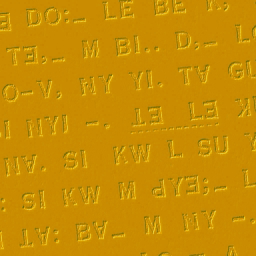Fraser alphabet
| Fraser | |
|---|---|
 | |
| Type | |
| Languages | Lisu |
| Creator | James O. Fraser |
Time period | c. 1915–present |
Parent systems | |
| Direction | Left-to-right |
| ISO 15924 |
Lisu, 399 |
Unicode alias | Lisu |
| U+A4D0–U+A4FF | |
The Fraser alphabet or Old Lisu Alphabet is an artificial script invented around 1915 by Sara Ba Thaw, a Karen preacher from Myanmar, and improved by the missionary James O. Fraser, to write the Lisu language. It is a single-case (unicameral) alphabet.
The alphabet uses uppercase letters from the Latin script, and rotated versions thereof, to write consonants and vowels. Tones and nasalization are written with Roman punctuation marks, identical to those found on a typewriter. Like the Indic abugidas, the vowel [a] is not written. However, unlike those scripts, the other vowels are written with full letters.
The Chinese government recognized the alphabet in 1992 as the official script for writing in Lisu.
Consonants
Note: You may need to download a Lisu capable Unicode font if not all characters display.
| Labial | Alveolar | Alveolar sibilant | Post- alveolar | Velar | Glottal | ||
|---|---|---|---|---|---|---|---|
| Plosive | Tenuis | ꓑ [p] | ꓔ [t] | ꓝ [ts] | ꓚ [tʃ] | ꓗ [k] | 1 |
| Aspirate | ꓒ [pʰ] | ꓕ [tʰ] | ꓞ [tsʰ] | ꓛ [tʃʰ] | ꓘ [kʰ] | ||
| Voiced | ꓐ [b] | ꓓ [d] | ꓜ [dz] | ꓙ [dʒ] | ꓖ [ɡ] | ꓨ [ɦ]3 | |
| Fricative | Voiceless | ꓩ [ɦ] | ꓢ [s] | ꓫ [ʃ] | ꓧ [x] | ꓦ [h̃]3 | |
| Voiced | ꓪ [v] | ꓤ [z] | ꓣ [ʒ] | ꓭ [p]?, [ɣ]2 | |||
| Nasal | ꓟ [m] | ꓠ [n] | ꓥ [ŋ] | ||||
| Approximant | ꓪ [w], [u̯]2 | ꓡ [l] | ꓬ [ʝ], [i̯]2 | ||||
- Initial glottal stop is not written. It is automatic before all initial vowels but [ɯ] and [ə].
- ꓭ sometimes represents a "vowel", presumably a medial [p], and sometimes a consonant [ɣ]. ꓪ and ꓬ are likewise ambiguous.
- ꓨ only occurs in an imperative particle. It is an allophone of ꓦ [h̃], which causes nasalization to the syllable.
Vowels
| Front | Central/back | |||
|---|---|---|---|---|
| High | ꓲ [i] | ꓵ [y] | ꓶ [ɯ] | ꓴ [u] |
| Mid | ꓰ [e] | ꓱ [ø] | ꓷ [ə] | ꓳ [ʊ] |
| Low | ꓯ [ɛ] | ꓮ** [ɑ] | ||
- **Not written after a consonant.
For example, ⟨ꓝ⟩ is [tsɑ̄], while ⟨ꓝꓰ⟩ is [tsē].

Tones
Tones are written with standard punctuation. Lisu punctuation therefore differs from international norms: the comma is ⟨꓾⟩ (hyphen period), and the full stop is ⟨꓿⟩ (equal sign).
| ꓝ [tsɑ̄] | ꓝꓸ [tsɑ́] | ꓝꓹ [tsɑ̌] |
| ꓝꓻ [tsɑ̄ˀ]* | ꓝꓺ [tsɑ̄ˀ] | ꓝʼ [tsɑ̄̃] |
| ꓝꓼ [tsɑ̂ˀ] | ꓝꓽ [tsɑ̂] | ꓝˍ [tsɑ̄ɑ̂] |
- *It is not clear how the ⟨ꓻ⟩ mid tone differs from the unmarked mid tone.
The tones ⟨ꓸ⟩, ⟨ꓹ⟩, ⟨ꓺ⟩, ⟨ꓻ⟩ may be combined with ⟨ꓼ⟩ and ⟨ꓽ⟩ as compound tones. However, the only one still in common use is ⟨ꓹꓼ⟩.
The apostrophe indicates nasalization. It is combined with tone marks.
The understrike (optionally a low macron) indicates the Lisu "A glide", a contraction of [ɑ̂] without an intervening glottal stop. The tone is not always falling, depending on the environment, but is written ⟨ˍ⟩ regardless.
Unicode
The Fraser alphabet was added to the Unicode Standard in October, 2009 with the release of version 5.2.
The Unicode block for the Fraser alphabet, called Lisu, is U+A4D0–U+A4FF:
| Lisu[1] Official Unicode Consortium code chart (PDF) | ||||||||||||||||
| 0 | 1 | 2 | 3 | 4 | 5 | 6 | 7 | 8 | 9 | A | B | C | D | E | F | |
| U+A4Dx | ꓐ | ꓑ | ꓒ | ꓓ | ꓔ | ꓕ | ꓖ | ꓗ | ꓘ | ꓙ | ꓚ | ꓛ | ꓜ | ꓝ | ꓞ | ꓟ |
| U+A4Ex | ꓠ | ꓡ | ꓢ | ꓣ | ꓤ | ꓥ | ꓦ | ꓧ | ꓨ | ꓩ | ꓪ | ꓫ | ꓬ | ꓭ | ꓮ | ꓯ |
| U+A4Fx | ꓰ | ꓱ | ꓲ | ꓳ | ꓴ | ꓵ | ꓶ | ꓷ | ꓸ | ꓹ | ꓺ | ꓻ | ꓼ | ꓽ | ꓾ | ꓿ |
Notes
| ||||||||||||||||
See also
External links
- Omniglot entry on Fraser alphabet
- Proposal for encoding the Old Lisu script in the BMP of the UCS
- Issues in orthography development and reform by David Bradley
- Sample text from Michael Everson's website